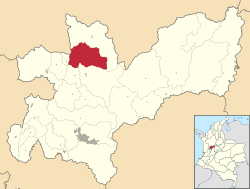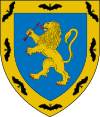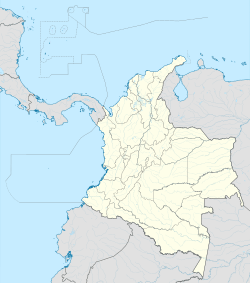Pácora, Caldas facts for kids
Quick facts for kids
Pácora
|
|||
|---|---|---|---|
|
Municipality and town
|
|||

Church of Saint Joseph
|
|||
|
|||

Location of the municipality and town of Pácora in the Caldas Department of Colombia
|
|||
| Country | |||
| Department | |||
| Founded | 1831 | ||
| Area | |||
| • Total | 234 km2 (90 sq mi) | ||
| Elevation | 1,819 m (5,968 ft) | ||
| Population
(Census 2018)
|
|||
| • Total | 13,214 | ||
| • Density | 56.47/km2 (146.3/sq mi) | ||
| Time zone | UTC-5 (Colombia Standard Time) | ||
Pácora is a town and a municipality in Colombia. It is located in the northern part of the Caldas Department, high up in the Andes Mountains. The town has a pleasant average temperature of 18 °C (64 °F) all year round.
Pácora shares its borders with several other towns. To the northeast is Aguadas, Caldas, and to the south are Salamina, Caldas and La Merced. To the west, the Cauca River separates Pácora from Marmato and Caramanta in the Antioquia department. The municipality of Pácora includes several smaller villages like San Bartolomé, Castilla, Las Coles, Los Morros, San Lorenzo, and Buenos Aires.
Contents
History of Pácora
Early Inhabitants: The Quimbaya People
Long ago, the area around Pácora was home to native groups like the Pozos, Armas, and Paucuras. These groups were part of the Quimbaya civilization. When the Spanish explorer Jorge Robledo arrived, he saw these native people wearing beautiful gold jewelry.
Robledo was looking for riches. He chased the native groups, but they disappeared into the thick jungle near a creek called Pácora.
Important Historical Sites
Pácora has a special historical place called the Stone-Cave of Pipintá. It is located on Loma de Pozo, about 1500 meters (4921 feet) above sea level. This huge rock hides entrances to a cave system. The Pozos people used these caves as a trade route to nearby towns like Arma and the gold-mining town of Marmato, Caldas.
In the village of San Bartolomé, there is a bar called Pimaraque. It has wall murals that show the history of the Pozo Indians, the Stone-Cave of Pipintá, and even the story of Jorge Robledo.
The Spanish Conquistador Jorge Robledo
Jorge Robledo (conquistador) was a Spanish explorer born in Spain in the early 1500s. He came to the Americas in 1528. As a conquistador, he founded several towns in Colombia. He established Anserma in 1539, Cartago, Valle del Cauca in 1540, and Santa Fe de Antioquia in 1541.
In 1542, Captain Miguel Lopez Munoz founded the town of Santiago de Arma. Later, in 1546, Jorge Robledo died in Pácora. This happened after a disagreement over land with Sebastián de Belalcázar, who was the Governor of Popayán.
Founding of Modern Pácora
In 1786, settlers from Antioquia moved into the nearby lands. After some challenges with moving the town of Santiago de Arma, these settlers founded a new town on December 6, 1831. They named it Arma Nuevo, which is now Pácora.
On October 12, 1832, the local government decided that the town should be moved to the current location of Pácora. A total of 1172 people moved to the new site. Cornelio Marin, who was a chief justice and one of Pácora's founders, helped divide the land among the new residents.
Geography and Nature
Pácora is part of a large forest reserve that stretches from Manizales to Sonsón. This area is rich in nature. You can find tall pine trees on the mountain tops and many different types of timber trees.
The region is also home to diverse wildlife. There are 22 different families of mammals. Along the banks of the Cauca river, you can find many fish, reptiles, and amphibians. Pácora has plenty of water sources, including the Cauca, Pozo, and San Lorenzo Rivers, and the Guarguarabá and La Mica streams.
Economy and Coffee Culture
Pácora is a key part of the Colombian Coffee-Growers Axis. The main economic activity here is growing coffee, with over 4,000 hectares dedicated to it. In 2011, the municipality became part of the "Coffee Cultural Landscape," a UNESCO World Heritage Site. This means the way coffee is grown and the culture around it are considered very special and important to the world.
Sugarcane is the second most important farm product. It is processed in 86 local mills. Pácora also has a strong livestock industry, with over 9,000 cattle. There are also more than 60 ponds and fish farms. Recently, the town has started making powdered sugarcane, which is sold in Manizales and Medellín.
Culture and Landmarks
Saint Joseph Church
The Saint Joseph Church is the most important building in Pácora. It combines different architectural styles, including Renaissance, Baroque, and Colonial. The front of the church is decorated with columns and arches. The windows have beautiful stained-glass images. The church bells, named Juana and Maria, were made in 1893 in Troy, New York. They were crafted from gold, silver, and bronze.
Bolívar Square
Bolívar Square is the main plaza in Pácora. This is where you'll find the town's administrative offices, the City Hall, the House of Culture, and the Saint Joseph Church. There is also a statue honoring Simón Bolívar, who was a very important leader in Colombia's history.
The House of Culture
The House of Culture is named after the artist Guillermo Botero Gutierrez. It is a place that promotes different cultural and artistic activities in Pácora. Inside, you can find a museum with ancient artifacts from before Columbus arrived. It also has old photographs and historical records from 1832 to 1950, showing how the town grew.
Tourism and Festivals
The Coffee Cultural Landscape
On June 25, 2011, UNESCO World Heritage Site declared the Coffee Cultural Landscape of Colombia a World Heritage Site. This special area covers parts of Caldas, Quindío department, Risaralda department, and Valle del Cauca department. Pácora, along with 16 other municipalities in Caldas, is part of this important cultural landscape.
Water Festival
The first Water Festival in Pácora took place in 1960. Since 1989, this fun festival happens every two years in October. People of all ages visit the monument of Christ the King and listen to the bells of Saint Joseph Church. Visitors can enjoy traditional food and take part in parades, exhibitions, and musical concerts.
See also
 In Spanish: Pácora para niños
In Spanish: Pácora para niños




